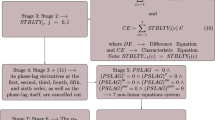Abstract
In this paper a fast perturbation algorithm for the design of linear phase FIR digital filters of finite wordlength is presented. The original set of filter coefficients are obtained using the Parks-McClellan algorithm, then a small perturbation is given to these sets of coefficients. The peak deviations corresponding to the rounded set of coefficients obtained from the original and the perturbed sets are compared and the set of coefficients with the lower value of peak deviation is stored as the best set of coefficients. A further perturbation is given to the infinite precision coefficents and these are rounded to the required wordlength. Comparison is made between these rounded sets and the present best set with respect to peak deviation and the better set is stored as the best set of coefficients. This process is repeated for a finite number of times or until the peak deviation is sufficiently low. To obtain the compensating filter coefficients single-frequency filters are used. Mathematical justification for the single-frequency design is given. Important results for a large number of design examples are presented to illustrate the speed and effectiveness of the algorithm.
Similar content being viewed by others
References
J. H. McClellan, T. W. Parks, and L. R. Rabiner, A computer program for designing optimum FIR linear phase digital filters,IEEE Trans. Audio Electroacoust., vol. 21, pp. 506–526, Dec. 1973.
Y. C. Lim and S. R. Parker, FIR filter design over a discrete powers-of-two coefficient space,IEEE Trans. Acoust. Speech Signal Process., vol. 31, pp. 583–591, June 1983.
Y. C. Lim, Predictive coding for FIR filter wordlength reduction,IEEE Trans. Circuits and Systems, vol. 32, pp. 363–372, April 1985.
A. Fettweis, Digital circuits and systems,IEEE Trans. Circuits and Systems, vol. 31, pp. 31–48, Jan. 1984.
P. Janardhanan and M. N. Neelakantan, Very fast method for the design of FIR digital filters with linear phase,IEEE Trans. Circuits and Systems, vol. 35, pp. 253–254, Feb. 1988.
D. S. K. Chan and L. R. Rabiner, Analysis of quantization errors in the direct form for finite impulse reasonse digital filters,IEEE Trans. Audio Electroacoust., vol. 21, pp. 354–366, Aug. 1973.
Unpublished work of the authors.
Author information
Authors and Affiliations
Rights and permissions
About this article
Cite this article
Janardhanan, P., Neelakantan, M.N. A fast perturbation method for the design of linear phase fir digital filters of finite wordlength using single-frequency filters. Circuits Systems and Signal Process 10, 233–244 (1991). https://doi.org/10.1007/BF01183773
Received:
Issue Date:
DOI: https://doi.org/10.1007/BF01183773




